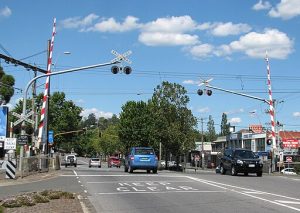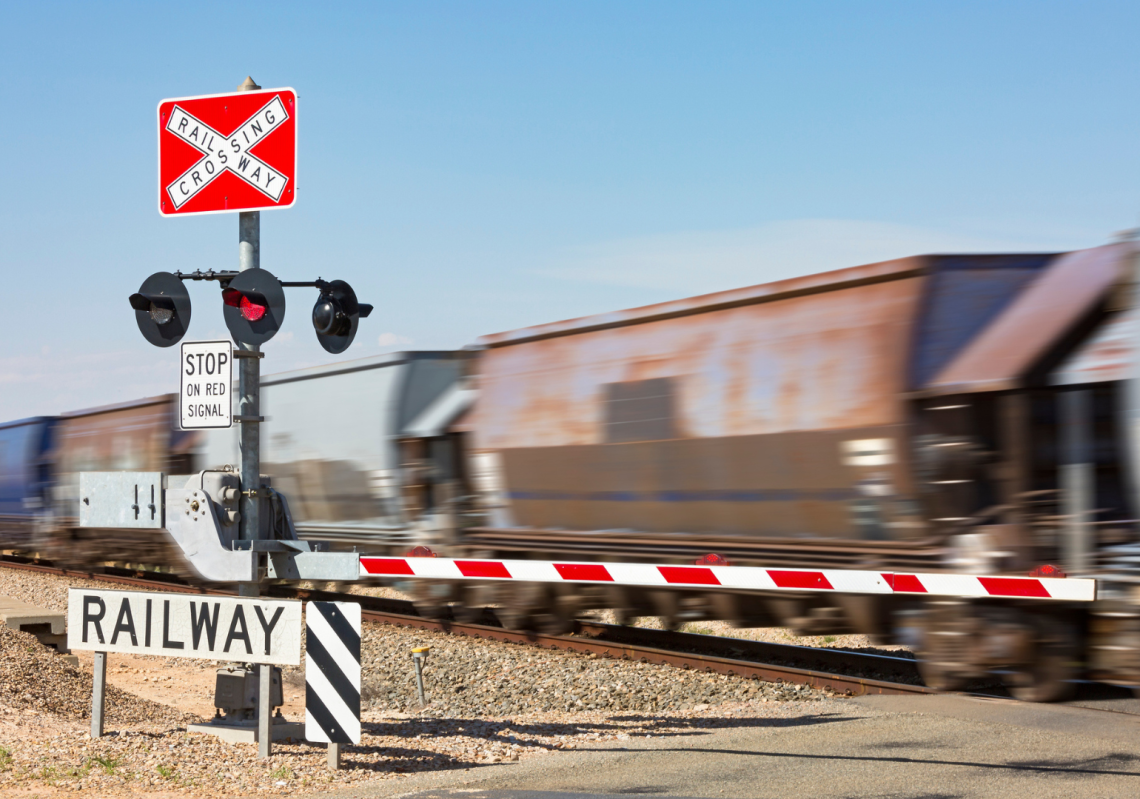Level crossings have long been a hazard. Mandatory requirements around lighting and visibility will help to prevent accidents.
Regional level crossing crashes pose one of the greatest risks to human life involving railways. At a level crossing in Woy Woy on the New South Wales Central Coast in April, a commuter train hit a car that made a wrong turn – with the driver making a lucky escape by jumping out of the vehicle just in time.
While a recent review of the Australian Standard 7531 Rolling Stock Lighting and Visibility, produced by the Rail Industry Safety and Standards Board (RISSB), was released in December 2023, experts argue that it’s already out of date.
A fatal crash occurred at a level crossing across a mainline route near Cutana in South Australia soon thereafter, and RISSB has revealed the Standard will be subjected to further review.
In response to a request from Ministers, the Office of the National Rail Safety Regulator (ONRSR) prepared a Draft Rail Safety Code of Practice for consideration, to which Engineers Australia’s Transport Australia Society (TAS) made a submission.
Dr Brett Hughes, Principal at P7Safety Adjunct Professor, Spatial Sciences at Curtin University and chair of the TAS Road Safety Working Group, explained the immediate action that needs to be taken.
A complex problem
As an interface between two different types of transport – involving different vehicles, regulators, infrastructure, operators, government organisations and associations – level crossing safety is tricky to navigate.
“The improvements for level crossing safety must be multifaceted, and include multiple participants and countermeasures,” Hughes said. “There are no silver bullets.”
While education and regulation are often the go-to strategies, enforcement across 24,000 level crossings and 20 million road users is no mean feat. In fact, most (around 19,000) of Australia’s level crossings are “passive”, using Stop and Give Way signs rather than lights or boom gates.
Human error is often cited as the reason behind level crossing crashes, but Hughes said multiple factors are at play.
“Drivers respond to their circumstances, which can be affected by light, time of day, how they’re feeling, or whether they’re playing music,” he said.
Other factors include inability to judge the speed and distance of trains accurately.
Road users must judge speed and distance, something they tend to under and overestimate. Getting it right can be the difference between life and death. While the logical thought might be to stop until the train passes, it’s not always that simple.
“You don’t know whether the train is travelling 40 or 100 km an hour, or if it has stopped,” Hughes explained.
To prevent collisions, road users must be given every opportunity possible to make a safe decision.
“If we can give people better indications when a train is approaching and at what speed, they can respond properly,” he said. “That’s why visibility is so important.”
A mandatory code for everyone
The updated code is broad in scope, covering the aspects of rail and road infrastructure within the powers of Rail Safety National Law (RSNL) and ONRSR, along with managing level crossing risks, technical requirements, risk installations and maintenance as well as human factors influencing the responses of road users.
However, parts of the code don’t relate to all road users, including farm tractors, caravans, pedestrians and cyclists. Inexperienced drivers or older drivers are also not accounted for.

“For example, normal people need about twice as much light to see at night [for] every 13 years of life,” Hughes said. “There are multiple types of road users and they all need to be taken into account in the code.”
In its submission, TAS emphasised the need to require railway operators to implement any measures that improve level crossing safety. Mandatory visibility requirements exist for most other forms of transport, including trucks, aircraft and dinghies. Even cyclists have mandatory visibility requirements, including reflectors and front-and-back lightning.
“The visibility requirements for trains are completely voluntary, because there are no specific regulations,” he said. “The Australian Standard is also far below the standard required for trucks for instance, which require side lighting, high standard reflectors and flashing lights for oversized trucks.”
Lack of requirements to implement safety upgrades in the code allows rail operators to make excuses or “argue interminably”.
“There needs to be enough strength behind a regulation, otherwise it leaves the opportunity to delay unendingly,” Hughes said.
Key lighting and visibility recommendations
Current voluntary requirements for rail include a “very bright headlight” and basic reflectors on the sides of wagons.
But headlights don’t necessarily indicate that what’s approaching is a train, what speed it’s travelling at or how far away it is.
Ditch lights, located at the bottom of trains, are another voluntary requirement – but not all trains have them.
“For example, passenger trains tend to have a different pattern and they are not as visible,” Hughes said.
Reflectors on the side of trains are similarly held to a “pretty poor” standard. When people come up to level crossings, it can be tricky to see if trains are passing by because wagons are dark.
“The reflectors don’t work at wide angles, they get dirty, and they are not maintained,” he said.
Lighting up the sides of locomotives provides a better outline of the train to help drivers understand what it is, where it is, whether it’s moving or not, and how fast – and would be “reasonably practicable” to implement, Hughes explained.
“The Standard should have better reflectors as a first requirement, and in the longer term, lights should be required on the sides of wagons.”
Flashing lights is another key TAS recommendation, aligning with universally used standards that indicate a hazard to motorists.
“Whether it’s an indicator on the car in front, the flashing light on your dial to say you’re low on fuel, the ambulance coming up behind you or the roadworks in front of you – every time you see a flashing light, you know it’s a hazard,” he said.
“Trains, which are over a kilometre long, weigh up to 6000 t and are the greatest hazard to a road user, need a mandatory standard for flashing lights.
All new rolling stock should immediately conform to the new standards in the code, Hughes said.
“Secondly, existing rolling stock should be upgraded to meet the standards in the code within a realistic maintenance timeframe, which is around five years.”
Check out the full TAS submission to the Draft Rail Safety Code of Practice – Level Crossings and Train Visibility.




Simply moving the stopping point of traffic at least 100m either side of the railway line away from the current stopping location. Put lights,boom gates and also Pre warning signs with flashing lights 500 m and 1 km from stopping location of road traffic. Install video cameras that are activated by the train. If someone crosses whike lights are flashing, the train drover can report to train control…. Ask a train driver not some bureaucrat or user of the road traffic industry….
Do motor vehicles have lights and reflectors on the side. No they dont. they travel through intersections. I have worked in the rail industry for 38 years and have performed a lot of investigations. The fact is that every incident involved the motorist passing a red signal or a stop sign. Yes improvements can be made in clearing the sites and signage. The behaviour of some motorists astounds me. A few weeks ago a friend of mine was badly injured and will require months of hospital treatment when the trackmachine he was in was struck by a motor vehicle. It was in daylight the sun was not an issue. Visibility was of the track was good. The flashing lights were working. Traffic in other direction had stopped. I do not think that putting reflectors or side lights is going to change anything except bankrupt rail operators by transferring the liability to them, if they are not installed or maintained, not to mention the expense of having them on 100000s of wagons
This all completely misses the point and issues surrounding level crossings. Most incidents occur when cars or trucks directly ignore a stop sign. When the do obey the stop sign they make a decision weather to proceed or not and although my miss judge the distance they do not get hit by the train. When they ignore the stop sign and proceed without looking they get hit. Simply put red light cameras on all level crossings.
Reflectors on sides of wagons are good idea, but lights are not, because
either the batteries will be flat or vandals will steal them. Spend the
money on something more productive. Road user behaviour ought be
considered somewhere (it belongs in another document, but should be paired
with this one). Road law ought say to slow down 5 kph below designated
limit at every level crossing, regardless of whether it is signposted. This
will save putting up 200,000 signs (8 per crossing incl backup signs).
Slowing down DOES SOMETHING and reminds the brain to choose next safety
step. The NO SIGN policy would save $20m which could be better spent on
school library books.